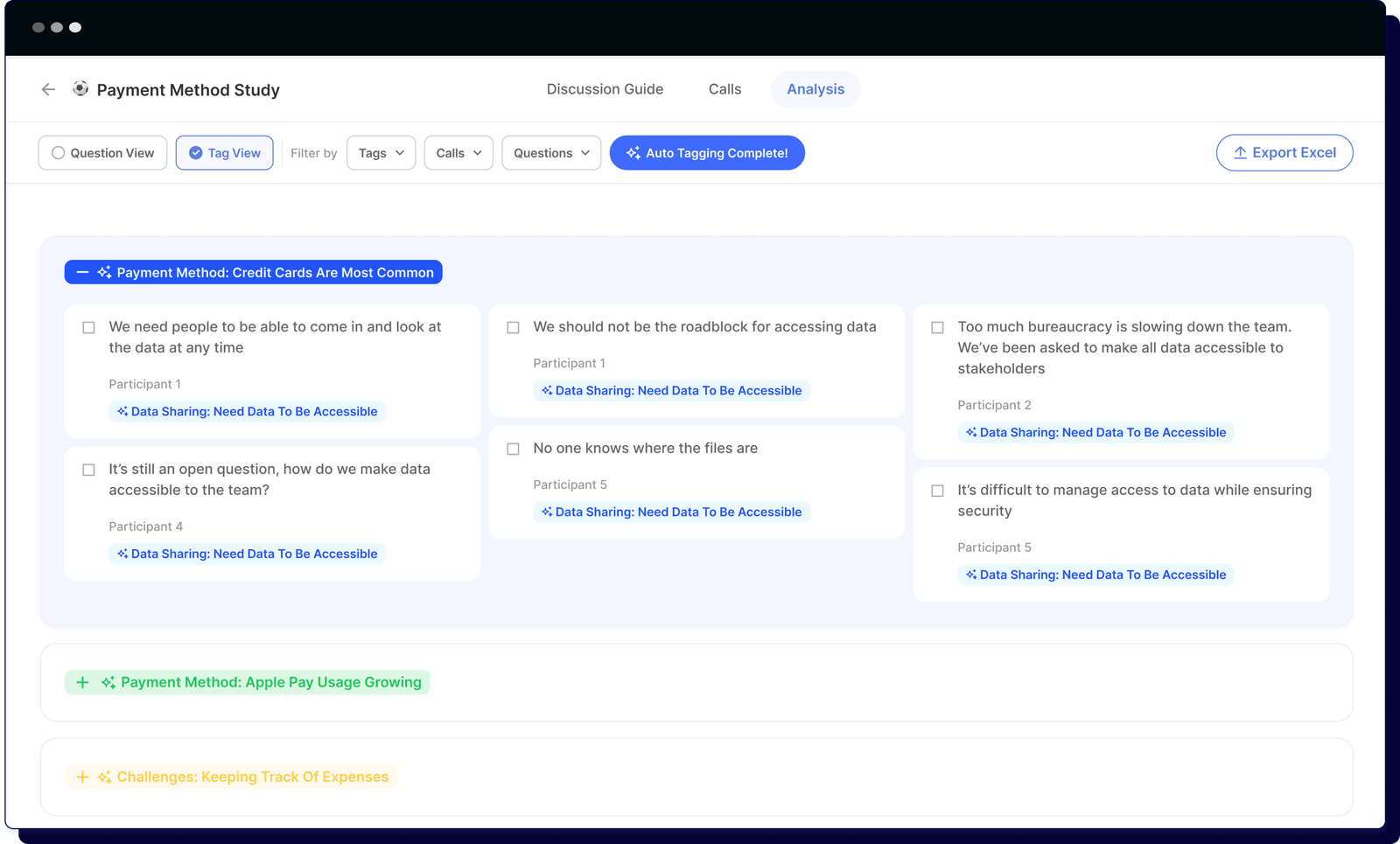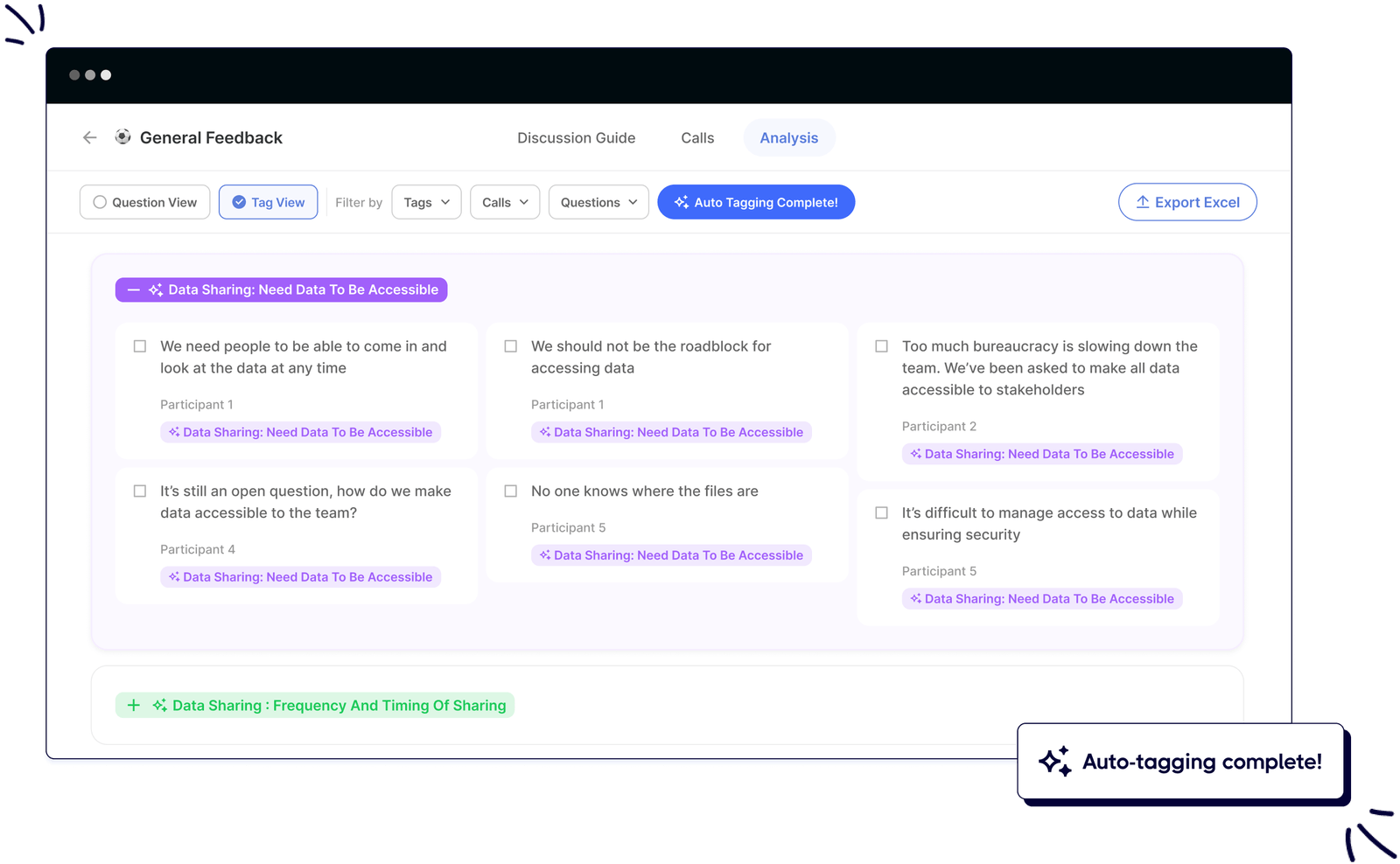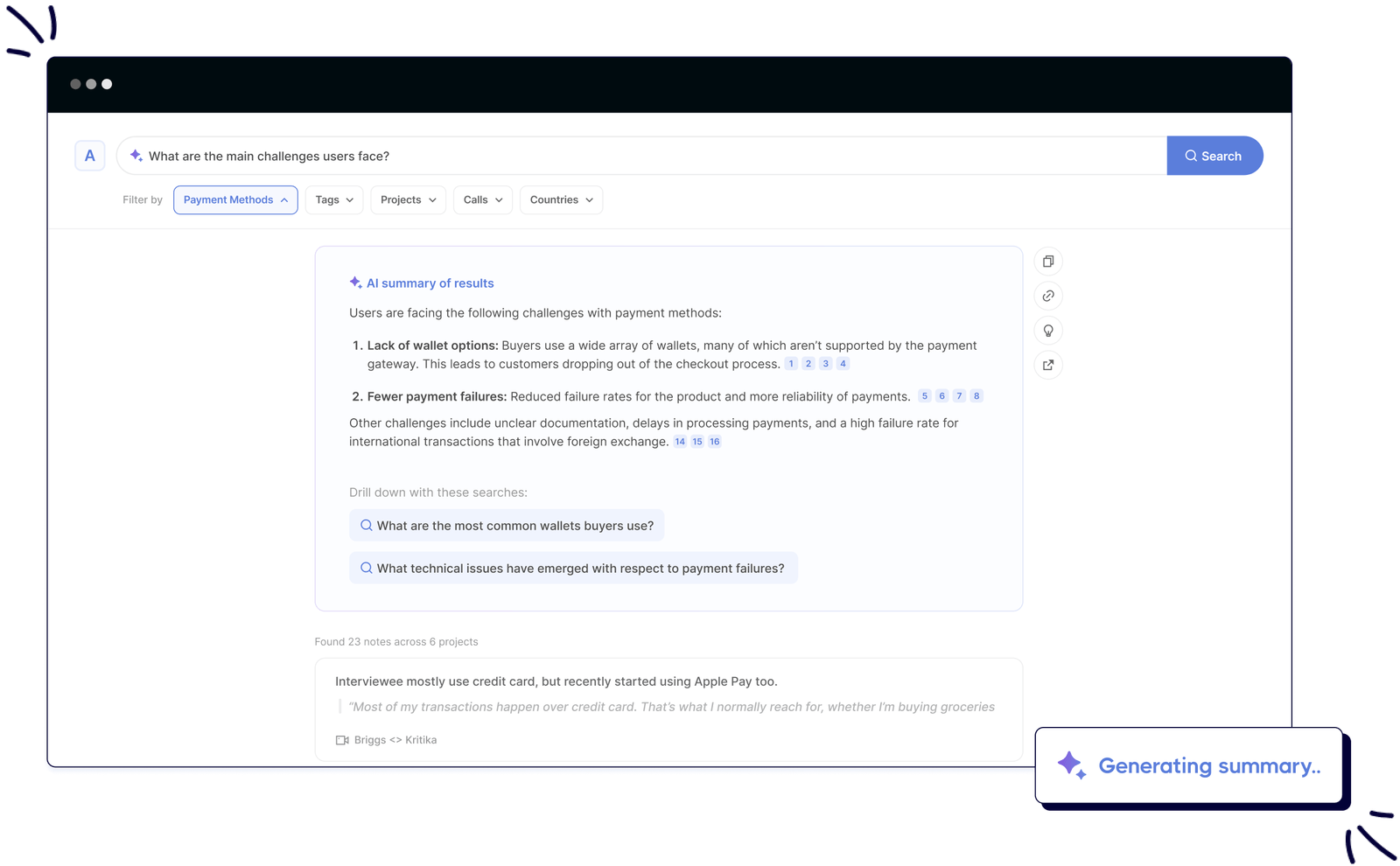User feedback is everywhere, whether collected through surveys, interviews, support groups, or even comments from social media handles.
This might overwhelm researchers and make them feel like they are standing in a crowded room where everybody is talking at once.
There might be some louder voices or some mumbled, while the rest are off-topic.
And here comes the real challenge, figuring out which voices matter.
More importantly, how do you streamline the user insight analysis process without being washed over by an ocean of spreadsheets?
The good news? There’s a smarter way to do it.
And we’ve made it easier for you to do streamlined user insights analysis, so instead of drowning in the data and scratching your head, you are more focused on making decisions that truly drive impact.
Key challenges faced by researchers in analyzing data
Data is the core element of UX research. While data can be collected from sources like customer feedback, interviews, and survey responses, analyzing such vast data is the real challenge.
Here are the common challenges that researchers might be facing:
- Too much data, too little time: Collecting user insights is easy, but analyzing them is the most painful task! Even small projects can generate large amounts of qualitative feedback that might take hours or even days to sift through.
- Noise from insights: Not every response makes sense. The biggest challenge for researchers is often sifting through irrelevant data and finalizing the information that really matters.
- Biasness: Researchers, even without realizing it, put their biases or team assumptions to shape data which might lead to erroneous conclusions.
- No structured analysis: Without clear frameworks or objectives, insights are lost in endless spreadsheets, where it becomes ever more difficult to recognize patterns and make informed decisions.
- Turning insight into action: Even after data analysis in qualitative research, it's not always easy to communicate findings in a way that will lead to actionable changes.
- Reporting: Researchers might fail to present a clear UX research report or summarize the findings, which could lead to even more confusion.
Best practices for streamlined user insight analysis

User insights are gold, but only if you can extract them efficiently. Otherwise, you will drown in a sea of data, questioning what is truly important. Here is how you cut through the clutter and turn raw information into meaningful and actionable insights.
Tip 1: Define clear research goals and metrics
Before you jump into gathering data, ask yourself: What am I trying to learn from this research?
Without a clear objective, you'll find yourself with an overload of information and no sense of direction. Here is how you can define clear research goals:
- Establish measurable criteria for what success would be. If you're testing a new feature, define what a "successful" outcome is in your mind.
- Align goals with business impact. The insights should lead to changes that improve user experience or product decisions.
- A well-defined goal not only makes analysis easier but also ensures you’re collecting the right data in the first place.
Tip 2: Using automated tools to gather and organize data

Once you’ve collected the data, the next step is organizing it for better analysis.
However, researchers know that manual sorting through user feedback, interview transcripts, and survey results is exhausting. But that's where automated research tools can do the heavy lifting for you.
For example, tools like Looppanel are built specifically for UX research, ensuring 90% accurate transcription of interviews and data summaries. It also categorizes user insights, identifies recurring themes up to 80% faster, and makes user analysis a breeze.
Here’s how you can leverage Looppanel:
- Automatic tagging & sentiment analysis: You can skip hours of tagging data and organizing them based on their themes. Looppanel automatically auto-tags the data and sorts recurring themes or patterns.

- Centralized repository: You can stop worrying about scattered docs and lost notes, Looppanel acts as a research repository and arranges all your research findings in one place to make collaboration effortless.

- Smart search: Want to find every time a user mentioned "confusing navigation"? Looppanel lets you search across all user feedback in seconds and even provides citations to help you track better.

Tip 3: Optimize the analysis process

Analyzing user insights can get overwhelming, but AI streamlines user insight analysis. It quickly scans through large datasets, recognizes patterns, and categorizes the feedback, saving hours of manual effort.
With AI, researchers can go beyond data sorting and focus on drawing meaningful conclusions. For example, with Looppanel, researchers can not only apply analysis methods like thematic analysis or sentiment analysis to detect themes/patterns but also create AI-executive summaries in minutes, no matter how diverse or large the dataset is.
Further, these AI-executive summaries are generated in a searchable and structured format that can easily be shared with peers. This guarantees faster, more accurate analysis without drowning in unstructured feedback.
That being said, AI is not enough on its own!
To get the most accurate insights, combine AI efficiency with human judgment. While AI finds the patterns, the interpretation by human beings guarantees those patterns translate into real user-driven decisions.
Tip 4: Use templates and visually appealing reports
When insights are easy to digest, they're more likely to drive action.
Remember, stakeholders won't be convinced by numbers and raw data but by a clear, well-structured report. Here’s how you can ensure that:
- Build a narrative: Tell a story with your findings instead of just a list of dry statistics; create a narrative that describes the user's journey.
- Visualize findings: Charts, heat maps, and infographics make insights clear and way more memorable than words in a text-heavy document.
- Use reusable/standardized templates:

Standardized reporting formats save time and ensure consistency across research studies. You can also use Looppanel’s free UX research report template to cut some time and focus on strategic insights rather than administrative work.
Tip 5: Prioritizing insights that drive action

As discussed earlier, not every piece of feedback deserves equal attention. The key is knowing what's worth acting on and what's just noise.
- Look for patterns: If multiple users mention the same problem, it's a priority.
- Align insights to business goals: Focus on findings that will have an impact either on user experience, retention, or revenue.
- Share findings with decision-makers: collecting and analyzing research data is not enough. Ultimately there should be a change! See that the right teams get the research so the insights don't just sit in a report.
Related read: How to uncover meaningful UX insights
Conclusion
Data analysis means more than just gathering numbers and feedback, it's about turning them into decisions to drive real impact. Without a clear path to action, even the most detailed insights become just noise. The goal? Cut through the clutter and extract what truly matters.
This is where Looppanel makes all the difference. It streamlines user insights analysis, emphasizes the main trends, and organizes findings so that you can act faster and smarter. No more drowning in raw data, just clear, actionable insights at your fingertips.
Ready to make sense of your research without the hassle? Request a demo today and see Looppanel in action!
Frequently asked questions (FAQs)
1. What is a streamlined user experience?
A streamlined user experience is effortless and seamless, where users can easily find their way and accomplish their tasks without confusion or frustration.
2. What is an example of a user insight?
Users prefer one-click checkout over multi-step forms, increasing conversions while lowering cart abandonments.
3. How to do user analysis in architecture?
Observe how people interact with spaces; gather feedback and use data to create environments that are intuitive.
4. What are user insights in UX?
Critical learnings about user behavior, needs, and pain points that help improve product design and experience.







.png)


.png)
.svg)



